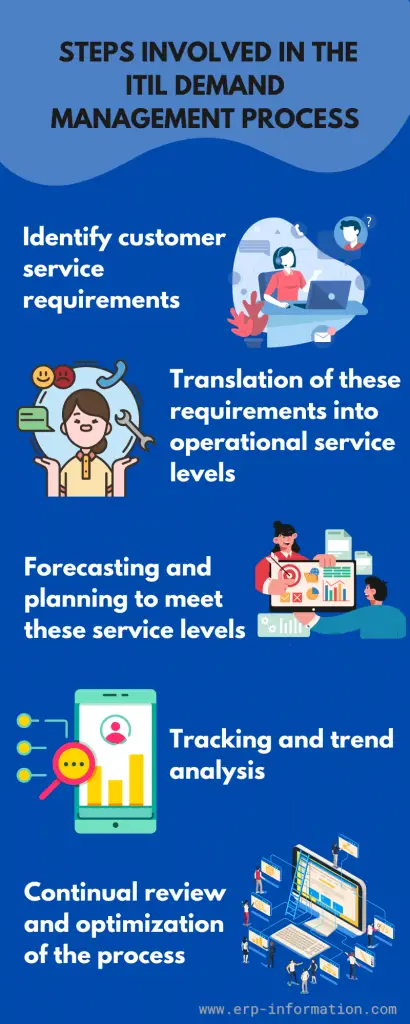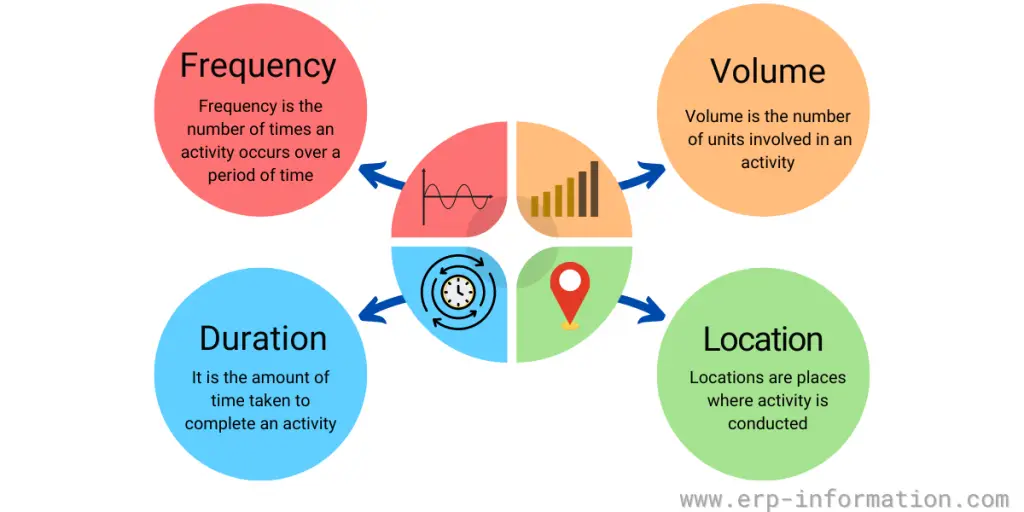The demand for IT services significantly influences the growth of an organization. To effectively manage this demand, many businesses rely on the Information Technology Infrastructure Library (ITIL) Demand Management.
By using ITIL demand management, you can create a framework for ensuring that your service levels are always maintained. In addition, it helps you identify and track current and future service demands so you can plan accordingly.
This process also allows you to optimize resources and prevent over or under-servicing customers.
In this blog post, we will explore the steps involved in the ITIL processes, the pattern of business activity (PBA), the benefits and challenges of ITIL demand management, and tips for success.
What is ITIL Demand Management?
ITIL demand management (Information Technology Infrastructure Library demand management) is the process of planning, tracking, and controlling the continuous delivery of IT services against agreed-upon service levels. It includes capacity planning, service portfolio management, ordering, and fulfillment strategies.
In its latest update in 2019, ITIL 4 expands its focus beyond just IT services to include all types of service management (ITSM). It defines this as “a set of specialized skills that organizations use to deliver valuable services to customers.” This change reflects a broader approach, aiming to meet the diverse needs of modern businesses more effectively.
It simplifies providing customer service in a quality-oriented, cost-effective manner. Demand management is an essential part of ensuring sustainable service levels.
What is ITIL?
ITIL, or the Information Technology Infrastructure Library, is a set of guidelines that helps businesses manage their IT Services Management (ITSM) and IT Assets Management (ITAM) effectively.
It outlines detailed processes and tasks tailored to align IT functions with corporate objectives, helping firms set standards and track compliance. While ITIL offers individual certifications, it does not provide organizational certification.
Evolution of ITIL
Originating in the 1980s from a set of best practices developed by the UK government, ITIL has evolved into a globally recognized framework. Its latest iteration, ITIL 4, integrates modern IT practices focusing on adaptability, collaboration, and customer-centricity, significantly enhancing service management across industries.
What are the Steps Involved in ITIL Demand Management?
There are five steps involved in the ITIL demand management process:
- Identify customer service requirements – This step involves understanding and documenting what the customers expect from your services.
- Translation of these requirements into operational service levels – Converting customer needs into specific, measurable service criteria.
- Forecasting and planning to meet these service levels – This step involves ensuring adequate resources are available to meet expected demands.
- Tracking and trend analysis – It can track changes in customer demand over time. This information can be utilized to identify trends and forecast the future market.
- Continual review and optimization of the process – Regularly updating and refining the demand management process to boost efficiency and effectiveness.
The Pattern of Business Activity (PBA)
The Pattern of Business Activity (PBA) concept in ITIL demand management refers to how an organization’s resources are used throughout the year.
Organizations typically have peak periods in their business activity, and the PBA helps identify these patterns so businesses can better plan their IT resources accordingly.
For example, suppose an organization knows its website usage typically increases significantly during the holiday season. In that case, it can plan accordingly by ensuring its servers handle increased traffic.
Based on PBA, we can measure the following aspects of customer service usage.
- Frequency – Frequency is the number of times an activity occurs over some time.
- Volume – Volume is the number of units involved in an activity.
- Duration – It is the amount of time taken to complete an activity.
- Location – Locations are places where activity is conducted.
Demand management VS. Capacity management VS. Availability management in ITIL
There is a slit difference between demand management, capacity management, and availability management in ITIL.
| ITIL Demand management | ITIL Capacity management | ITIL Availability management |
| Focuses on the volume and frequency of the service needed for the customer. | Focuses on the speed and efficiency of the service. | Focuses on service availability to support the client in fulfilling their business requirements. |
| It helps in understanding and anticipating the specific types and volumes of services that clients will require. This process involves direct engagement with clients to predict future needs, such as determining how often a client’s servers need to be backed up. | It ensures that the infrastructure and resources are adequately scaled and optimized to meet these demands efficiently, for instance, ensuring that server backups are conducted swiftly and effectively. | It concentrates on ensuring that these services are reliably accessible as per the standards set in service level agreements (SLAs), managing downtime and recovery to align with business needs, such as maintaining continuous availability for server backups. |
ITIL Demand Management Activities
Within the framework of ITIL Demand Management, a series of essential activities are carried out to streamline IT service provision.
These activities collectively form the backbone of ITIL Demand Management, ensuring that IT services are delivered effectively and in alignment with organizational objectives.
1. Service Catalog Management
This involves the meticulous establishment and ongoing maintenance of a comprehensive service catalog. This catalog serves as a repository of all available IT services and their detailed specifications.
2. Service Request Identification and Qualification
Rigorous processes are employed to systematically identify and assess new service requests. These requests are subjected to a qualification process to ensure alignment with organizational goals and IT capabilities.
3. Business Impact Assessment
A critical step involves evaluating the potential business impact of each service request. This assessment considers factors like cost, resource requirements, and strategic importance to the organization.
4. Service Request Prioritization
Service requests are systematically prioritized based on their significance and urgency. This prioritization ensures that the most critical requests receive prompt attention and allocation of resources.
5. Resource Allocation
Efficient allocation of resources is crucial for meeting the demands of service requests. Resource allocation is guided by the prioritization established earlier, ensuring optimal utilization of available IT resources.
6. Demand Monitoring and Reporting
A continuous process of monitoring and reporting on service request demands is maintained. This involves tracking the status of requests, resource utilization, and adherence to service level agreements (SLAs). The collected data provides valuable insights for process improvement and decision-making.
ITIL Demand Management Benefits
Improved Budget Management
By forecasting and aligning IT services with actual business needs, Demand Management enables organizations to allocate their budgets more effectively. This foresight helps in avoiding unnecessary expenditures by tailoring resources to match demand.
Enhanced Quality of Service
By aligning IT services closely with user expectations and demands, organizations can achieve a higher quality of service. This alignment ensures that services are not only available but also optimized for performance, leading to increased user satisfaction.
Increased Security
Effective Demand Management helps in anticipating and mitigating potential security threats by ensuring that services are designed with security in mind from the outset. This proactive approach reduces vulnerabilities and enhances overall IT service security.
Business Advantages
Demand Management provides a competitive edge by enabling quicker and more flexible responses to market changes.
This agility allows organizations to seize opportunities and adapt to new demands efficiently, giving them a strategic advantage in the marketplace.
Holistic IT Management
By integrating Demand Management with other IT service management processes, organizations can achieve a more cohesive and controlled IT environment.
This integration helps in smoother operations and better management of IT resources across the board, leading to overall operational excellence.
Challenges
Challenges of ITIL Demand Management:
Inaccurate Demand Forecasting
The most significant challenge in Demand Management is the risk of predicting customer needs incorrectly. This often leads to misallocated resources, where money and effort are spent on services that don’t align with actual demand.
Such inefficiencies can confuse customers about a service provider’s priorities, leading to dissatisfaction and wasted resources.
Limited Operational Insight
A lack of deep visibility into the business operations can hinder effective Demand Management. When Demand Management is not fully integrated with the company’s broader strategies, gathering necessary operational data becomes fragmented and inefficient.
This scenario complicates the process of managing requests for new or modified services, as it requires balancing immediate needs with long-term goals.
Managing Diverse Business Needs
Catering to the varied requirements of different business units within an organization poses a substantial challenge. Without a unified approach to service management, it becomes difficult to understand and prioritize the diverse needs accurately, assess their impact on value creation, and align services accordingly.
Tips for Success with ITIL
- Make sure that customer requirements are clearly understood and documented.
- Verify that service levels are realistic and achievable.
- Ensure that required resources are available to meet projected demand.
- Ensure the demand management process is reviewed and optimized regularly.
What Does Effective Demand Management Look Like?
Clear and Transparent Communication
The effective Demand Management lies in the power of clear communication. This involves continuous interaction between customers, IT service management (ITSM) teams, and business relationship managers.
These managers play an important role in bridging the gap between clients and ITSM, ensuring there is a common understanding of the scope and scale of services required. This transparency helps in building trust and aligning expectations.
In-depth Data Analysis
Strong Demand Management relies heavily on robust data analysis. By analyzing customer behavior and service usage patterns, whether it’s daily, weekly, or quarterly, teams can anticipate needs more accurately.
This ongoing process of data gathering and evaluation during various service phases ensures predictions are reliable and reflective of real demand.
This methodical approach not only improves service accuracy but also enhances customer satisfaction by proactively adjusting to their changing needs.
Cost Control
A defining feature of well-executed Demand Management is its ability to manage costs effectively. By preventing unexpected expenses, it supports other service delivery areas, allowing for better resource allocation and keeping spending under control.
Effective Demand Management ensures that financial planning is both strategic and aligned with the actual service requirements, helping maintain budget integrity and operational efficiency.
Balancing Act
Ultimately, good Demand Management maintains a delicate balance between fulfilling customer needs, maintaining high service quality, and managing organizational costs.
This balance is crucial as it ensures that all elements work together seamlessly, supporting broader business goals and contributing to overall success.
ITIL Demand Management in Virtualization and Cloud Computing
ITIL Demand Management plays an important role in optimizing technical resource allocation and ensuring cost-effective scalability in the domain of virtualization and cloud computing.
For example, consider an organization that has embraced a hybrid cloud model, utilizing both on-premises and cloud-based resources for its technical infrastructure.
The organization experiences a surge in demand for a specific technical application, resulting in increased resource consumption within its cloud environment.
In this case, demand management serves as the technical compass guiding resource allocation decisions. It involves:
Demand forecasting
Using historical data and technical analytics, IT teams anticipate spikes in demand for the technical application.
Business impact assessment
Technical experts assess the potential technical and business consequences of scaling resources in the cloud.
Technical resource allocation
Based on demand projections and technical evaluations, resources such as virtual machines and storage are dynamically allocated in the cloud to ensure optimal technical performance.
Performance monitoring
Continuous monitoring of technical performance metrics ensures that the application operates smoothly, and resources are allocated as needed.
Cost management
Demand Management also keeps a watchful eye on technical costs, ensuring that technical expenses remain within budget while delivering the necessary technical resources.
This application of ITIL Demand Management in virtualization and cloud computing showcases how technical organizations can balance the need for technical scalability with cost control and optimal technical performance.
Case Study: Alexo Enhances IT Service Management with ITIL and MyAxelos
Alexo, a provider of cloud-based solutions, faced challenges with inconsistent service levels and inefficient resource management. To address these issues, Alexo implemented ITIL 4 frameworks and utilized the MyAxelos toolkit to standardize processes and train staff. This strategic move resulted in improved service consistency, reduced operational costs, and more informed decision-making. Alexo continues to leverage ITIL best practices for ongoing improvements and business growth.
FAQs
What is the demand prognosis?
Demand prognosis in ITIL is a technique used to forecast future service needs based on historical data and trend analysis, enabling proactive resource planning.
Conclusion
Demand management is an important process in any organization, and the ITIL demand management process is no exception. With this framework’s help, you can ensure that your strategy is well-organized and efficient.
By taking the time to understand the steps involved, the PBA, and the benefits and challenges of implementing this process, you can set your organization up for success.


